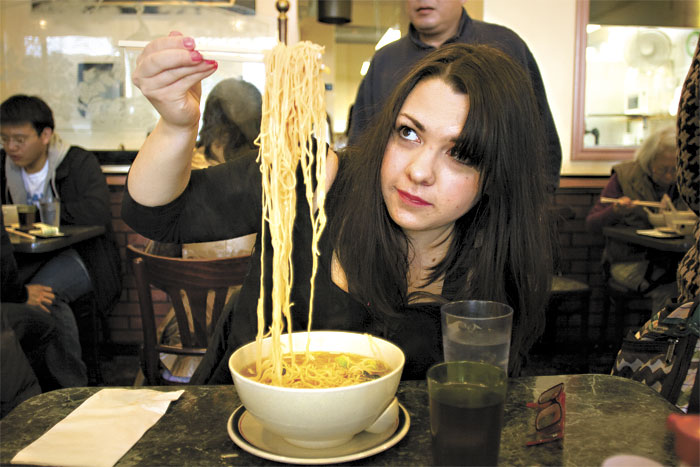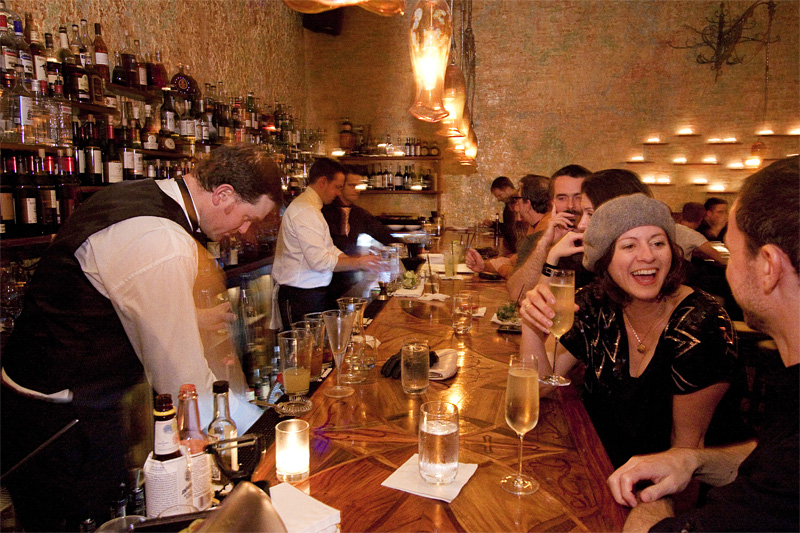This past fall, I embarked on a mission to ferret out the best noodle dishes the Puget Sound area has to offer. These weekly expeditions, chronicled every Monday on our food blog (www.seattleweekly.com/voracious), have become my favorite part of the week, taking me to bistros where I’ve delicately twirled handmade fettucine around the tines of a fork or to garish suburban restaurants where I’ve hoovered up Korean-Chinese soup noodles, covering my shirt in spicy red polka dots in the process. The quest is far from over, but here are the highlights to date:
Noodle: Sui kau and squid ball noodle soup
Source: Mike’s Noodle House, 418 Maynard Ave. S., 389-7099
Price: $7 for a big bowl with extra greens (bowls start around $4.50)
Sometimes all a man wants is a bowl of chicken noodle soup. No meat, no bacon-flavored pork stock, no vegetables, no garnish. That man is not me. Only if you bring me to Mike’s Noodle House can you whittle me down to chicken stock and noodles, but there have to be some squid balls and sui kau (pronounced sway kow) in the bowl too.
The reason I favor Mike’s over all the other Hong Kong–style noodle shops in the ID is its you mien (“skinny noodles”), which the owners import from Vancouver. Not much thicker than hairs, springy and stretchy, a little eggy, they’re as much texture as taste.
You can get a bowl of just stock with just noodles and a few yellow chives for garnish, but I’m devoted to the sui kau. They’re like mutant wontons, bloated, bursting with shrimp and mushrooms, and trailing silky wrappers in the soup as they float around the bowl. And the spongy, bland squid balls are another textural pleasure. There’s no “with baby bok choy” option on the menu, though, so the waitress will only add it to your order when you make a special request, giving you a suspicious look as she writes it down.
Noodle: Pancit palabok
Source: Manila Grove, Great Wall Mall, 18230 E. Valley Hwy., Kent, 253-347-4715, www.manilagroverestaurant.com
Price: $5.29
I’ve often heard pancit palabok described as the Filipino spaghetti with red sauce. It sounds like the most comforting food ever: rice noodles, seafood sauce tinted orange with annato seed, crumbled pork rinds, hard-boiled eggs, green onions. It’s also one of those dishes that I order time and time again, trying to like, though every version seems boringly one-note. But one of the cardinal rules of reviewing restaurants is that when you see lots of other diners eating a dish, you order it. Even though the pancit was practically listed in small print at the back of this mall restaurant’s menu, half the people around me were eating plates of it. So I made like a lemming.
It was certainly the best pancit palabok I’ve eaten yet, for one reason: pork density. The thick sauce didn’t have the tinge of seafood it often has—whether from crab, squid, shrimp paste, or fish sauce seems to differ depending on the maker—but the skinny white noodles were covered in a fine snow of crumbled fried pork rinds, so they tasted as if they’d been cooked in ham stock.
Noodle: Stir-fried shaved noodle with vegetables
Source: Jack’s Tapas Cafe (Mainly Chinese), 5211 University Way N.E., 523-6855, www.jackstapas.com
Price: $9.95
Besides having the best name in town, which refers to owner Jack Tai’s translation of xiao che (“small eats”), this place offers his great shaved noodles, a specialty of Shaanxi province in the northern half of China. The irregular, six-inch lengths look a little like wheat-colored banana slugs, and they’re appealingly chewy, stir-fried with cabbage, carrots, eggs, and onions, with a little soy and a little wok char for seasoning—chow mein with some heft. “The chef has a big block of dough, quite compact,” the server told me when I asked her how Tai made his noodles. “When you order, he has a special tool, like a peeler, that he uses to shave off the dough and cook the noodles. Then he stir-fries it.”
Noodle: Kao soi
Source: Noodle Boat Thai Cuisine, 700 N.W. Gilman Blvd., Suite E 104(b), Issaquah, 425-391-8096, www.noodleboat.com
Price: $7.25
Noodle Boat is the restaurant that all my friends who grew up in Thailand, or have traveled a lot there, tell me is their favorite. It’s only a 20-minute trip from Capitol Hill, plus another five minutes driving around the strip mall hunting for the tiny corner shop. The menu is printed on a fan. There is more purple in the restaurant than at a Red Hat Society convention. These are good signs.
The dish one friend instructed me to order: kao soi, or noodles in curry soup with pickled cabbage. Kao soi has a fascinating pedigree, picking up influences from Yunnan and Burma en route to Chiang Mai and now Washington state. The dish, which came in a ceramic noodle boat, was everything she described: bathed in a yellow coconut curry at once lime-tart and turmeric-fragrant, rounded out with enough fish sauce to detect. The sweetness from the coconut and the prickle of the chiles showed up later, entwined like a pair of lovestruck teenagers, while the pickled cabbage interrupted with shocks of salt and the fried noodles on top with crunchy flashes.
Noodle: Chee cheong fan
Source: Jade Garden, 424 Seventh Ave. S., 622-8181
Price: Always cheaper than I expect
Even after dozens of brunches at Jade Garden, the first 15 minutes are always a frenzy of instant gratification—I want that! and that! and that!—and then my friends and I sit under the arbor of plastic grapes, picking at the Chinese broccoli and whatever dumplings survived the gorgefest, until we get so stuffed we have to go home to sleep it off. Amid the scallop dumplings, salt-and-pepper squid, sticky-rice packets, and custard buns, I usually order up a plate of chee cheong fan: rice crepes wrapped around shrimp with a sweet soy sauce poured over. (Sometimes you’ll spot them wrapped around savory donuts and sprinkled with scallions; then they’re called char leung.) They’ve been one of my favorite dim sum treats since I moved to San Francisco after college, with their slippery, satiny texture that melts away in the mouth (tip: They’re a big hit with toddlers on white-food diets).
Chee cheong fan actually means “pig intestine noodle.” Not because they contain pork, but because when the soft white crepes are rolled up, they resemble guts. This, in Southern China, is a compliment.







